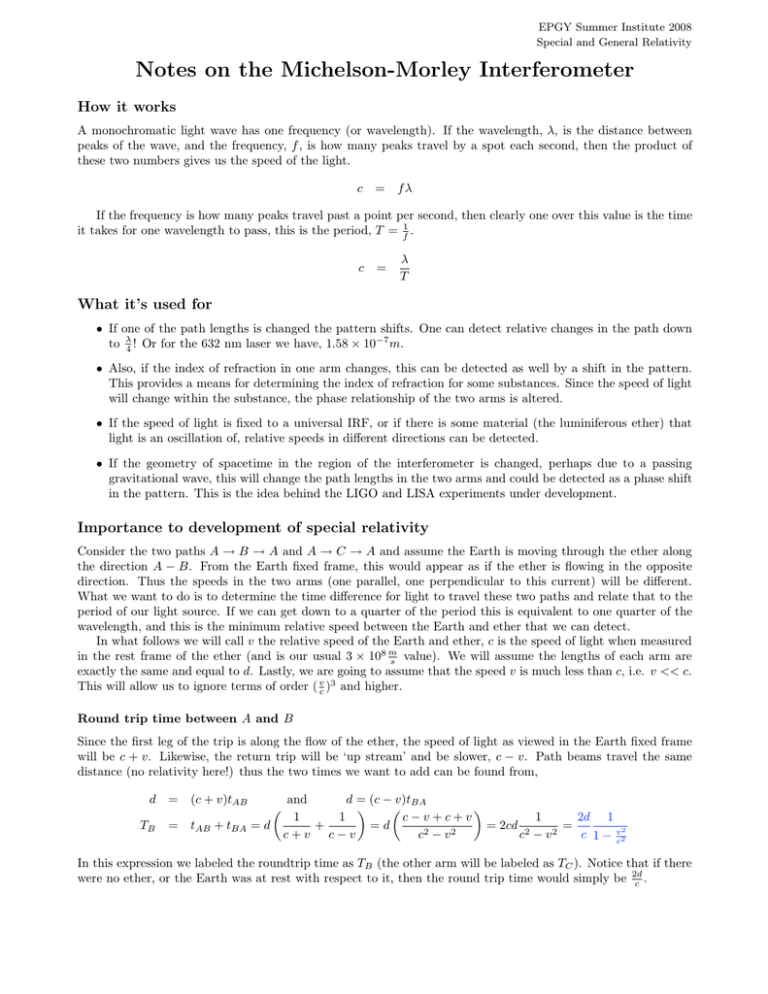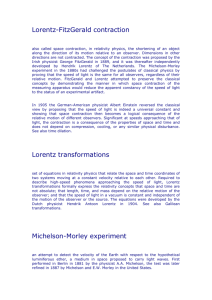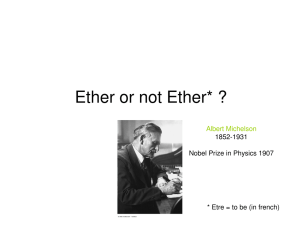Notes on the Michelson-Morley Interferometer
advertisement

EPGY Summer Institute 2008 Special and General Relativity Notes on the Michelson-Morley Interferometer How it works A monochromatic light wave has one frequency (or wavelength). If the wavelength, λ, is the distance between peaks of the wave, and the frequency, f , is how many peaks travel by a spot each second, then the product of these two numbers gives us the speed of the light. c = fλ If the frequency is how many peaks travel past a point per second, then clearly one over this value is the time it takes for one wavelength to pass, this is the period, T = f1 . c = λ T What it’s used for • If one of the path lengths is changed the pattern shifts. One can detect relative changes in the path down to λ4 ! Or for the 632 nm laser we have, 1.58 × 10−7 m. • Also, if the index of refraction in one arm changes, this can be detected as well by a shift in the pattern. This provides a means for determining the index of refraction for some substances. Since the speed of light will change within the substance, the phase relationship of the two arms is altered. • If the speed of light is fixed to a universal IRF, or if there is some material (the luminiferous ether) that light is an oscillation of, relative speeds in different directions can be detected. • If the geometry of spacetime in the region of the interferometer is changed, perhaps due to a passing gravitational wave, this will change the path lengths in the two arms and could be detected as a phase shift in the pattern. This is the idea behind the LIGO and LISA experiments under development. Importance to development of special relativity Consider the two paths A → B → A and A → C → A and assume the Earth is moving through the ether along the direction A − B. From the Earth fixed frame, this would appear as if the ether is flowing in the opposite direction. Thus the speeds in the two arms (one parallel, one perpendicular to this current) will be different. What we want to do is to determine the time difference for light to travel these two paths and relate that to the period of our light source. If we can get down to a quarter of the period this is equivalent to one quarter of the wavelength, and this is the minimum relative speed between the Earth and ether that we can detect. In what follows we will call v the relative speed of the Earth and ether, c is the speed of light when measured in the rest frame of the ether (and is our usual 3 × 108 m s value). We will assume the lengths of each arm are exactly the same and equal to d. Lastly, we are going to assume that the speed v is much less than c, i.e. v << c. This will allow us to ignore terms of order ( vc )3 and higher. Round trip time between A and B Since the first leg of the trip is along the flow of the ether, the speed of light as viewed in the Earth fixed frame will be c + v. Likewise, the return trip will be ‘up stream’ and be slower, c − v. Path beams travel the same distance (no relativity here!) thus the two times we want to add can be found from, d TB = (c + v)tAB = tAB + tBA = d ! and d = (c − v)tBA " ! " 1 1 c−v+c+v 1 2d 1 + =d = 2cd 2 = 2 2 2 c+v c−v c −v c −v c 1 − vc22 In this expression we labeled the roundtrip time as TB (the other arm will be labeled as TC ). Notice that if there were no ether, or the Earth was at rest with respect to it, then the round trip time would simply be 2d c . Round trip time between A and C Now the light travels perpendicular to the ‘current’ and in order for it to travel to the mirror and back, which takes a finite time, it will have to travel at some angle due to v. If we switch to the frame fixed to the ether, we see that the interferometer will be traveling with speed v to the right now. In the time it takes for the light to leave and return to A, the interferometer has moved a distance vTC (recall that TC is the round trip time to C). In this frame light travels at c since the ether is at rest. If we examine the journey A → C and apply the Pythagorean theorem to the right triangle we get, ( vTC 2 ) + d2 2 = ( cTC 2 ) 2 or, 4d2 = TC2 (c2 − v 2 ) TC = Time difference for both paths 2d 1 # c 1− −→ TC2 = 4d2 c2 − v 2 v2 c2 The time difference that we are after (∆t) is difference of our two results, ( ) 2d 1 1 2d v 2 −1 v2 − 1 2 ∆t = TB − TC = −# (1 − 2 ) − (1 − 2 ) 2 c 1 − vc22 c c c 1 − v2 c Using the binomial expansion we have, ∆t ≈ ∆t = ( ) v2 1 v2 2d 1 v 2 2d (1 + 2 + · · ·) − (1 + + · · ·) = c c 2 c2 c 2 c2 2 dv c3 Michelson’s interferometer We see from this result that the larger d is, the larger time difference we can obtain and thus smaller relative velocities might be detectable. Michelson being a skillful experimentalist, lengthened each arm by having the light reflect multiple times in each arm. The effective length in his early experiment of 1887 was 11 meters. Thus the arrival time difference for the two paths could be resolved down to about, ∆tM M = 2 (11m)v 2 −25 s )v 2 m 3 = (4 × 10 8 (3 × 10 s ) m2 In the original MM experiment, sodium light was used which has a pair of closely spaced yellow wavelengths about 589nm. Thus the period of this light is about TN a = λc = 2 × 10−15 s and one quarter of this value is about 5 × 10−16 s. By refining the process and careful analysis Michelson and Morley could detect down to one one T hundredth of the period, 100 = 2 × 10−17 s. Using this as the limit we find that this experiment could measure relative Earth-ether velocities down to, * + ∆tM M 2 × 10−17 m m v = = = 7000 2 −25 s −25 4 × 10 s s 4 × 10 m2 In their paper they claimed a resolution of 8000 m s . Of course by keeping the interferometer fixed you can not determine any phase shifts (nothing is changing!). So to observe these shifts they placed their interferometer on a concrete slab and floated it in a pool of mercury. By slowly rotating the interferometer through 90o one should expect to see the fringes move since you are swapping the AB and AC directions. As you probably know, they never observed any change within experimental uncertainty. Again they eliminated any relative speed of the Earth-ether system down to 8 km s . What should one expect for the relative speed? The Earth travels around the Sun at a speed of 30 km s , thus if the Earth travels smoothly through the ether (there is no local change as the ether flows around the Earth) then we should expect to see fringes to shift. The expected shift is 0.4 of a fringe and MM found none down to about 0.01 of a fringe. Of course later experiments provided better results. Can we determine anything? For our little MM interferometer can we say anything? The path length in this little guy is about 10cm (measure to verify) so clearly we can not make any grand claims about the Earth’s movement about the Sun. But perhaps there are other relative motions we can analyze, let’s see how well we can do. For d = 0.1m and using λ = 632nm → T = 2.1 × 10−15 s for our laser we have, (with v = + c3 ∆tus = d + (2.7 × 1026 , m2 m 13 )∆t = 1.6 × 10 ∆tus us s3 s Let’s assume we can observe down to a quarter of a period, then we have T2 ≈ 1 × 10−15 s. Inserting this into the previous expression we find, , m m v = 1.6 × 1013 1 × 10−15 ≈ 500, 000 s s Clearly we have no way to make any statement about the Earth’s movement about the Sun, but what of other peculiar velocities? Are any of these of the order or greater than our device? Let’s look at some data. (Of course, all of this assumes we are being very careful in our experiment -which we are not). Some relative velocities for Earth So let’s move out from our solar system and figure the relative speeds of our solar system with respect to larger objects. • Motion about MW The speed of our solar system around the center of the Milky Way galaxy is a little more than 200 km s - No luck for us. (This is based on 270 million years to orbit the MW). • Motion of Sun to the Local group. The local group of galaxies consists of the Andromeda galaxy, Triangulum galaxy and other smaller galactic objects. It is about 10 million ly across. The Sun is moving at 308 km s towards the center of mass of this system. Closer, but still no luck. • Motion towards Virgo Supercluster The local group is part of a larger structure, the Virgo supercluster, the center of which lies about 55 million ly from here. The size of the Virgo supercluster is about 100 million ly in diameter. (Need to find peculiar velocity). • Motion towards the Great Attractor As we proceed outward the measurements of relative velocities becomes less accurate. However, it is known that the Virgo supercluster is moving at a great speed toward the “Great Attractor” which actually consists of two separate attractors that are 200 million ly and another 600 million ly behind it. Estimates of the velocity towards this object range from 600 to 1000 km s . Perhaps we could eliminate this. • Motion with respect to CMB. The recent results from the WMAP probe have given a value of about 370 km s between the barycenter of our solar system and the CMB [1]. Earlier estimates went as high as km 627 s . Perhaps a measurement could be said here but probably not. Of course one could argue the validity of these arguments, perhaps the ether should be flowing along with these same peculiar velocities. However, a simple determination with respect to a universal frame (as assumed in the original experiment) could be made. Also problematic is the addition of all these peculiar velocities to get a net velocity. However, the best bet we have is eliminating any ether that the Virgo supercluster moves toward the Great Attractor (above 600 km s ). To properly eliminate this we would need to align the arms of our interferometer parallel and perpendicular to this velocity component. The motion with respect to the CMB has been determined to be toward (l = 276o , b = 30o ) which lies in the constellation Hydra. Very recent measurements indicate that we (MW galaxy and local group) are being pushed away a nearby local void. The peculiar velocity of which has been measured to be 268 km s . Modern uses (LIGO and LISA) Appendix: Details of Michelson’s work References [1] G. Hinshaw, et al. Five-Year Wilkinson MIcrowave Anisotropy Probe (WMAP) Observations: Sky Maps, & Basic Results, Astrophysical Journal Supplement Series. (2008).



